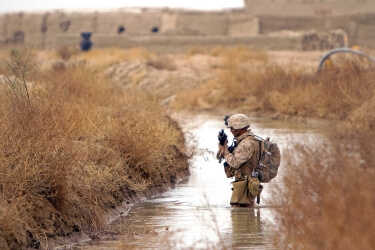
The Counterrevolution in Strategic Affairs
Claims from the 1990s about a revolution or transformation in military affairs are assessed in light of the experience of the 2000s in Iraq and Afghanistan. The importance of considering political as well as military affairs is stressed. Though the United States developed evident predominance in capabilities for regular war, it was caught out when drawn into irregular forms of warfare, such as terrorism and insurgency. The United States significantly improved its counterinsurgency capabilities. It does not follow, however, that the United States will now engage more in irregular conflicts. Indeed, the military circumstances of the past decade were in many ways unique and led to an exaggeration of the strategic value of irregular forms and the need for the United States to respond. Meanwhile, the political legacy of the experience is likely to be a more limited engagement with the problems associated with “failed” and “rogue” states.
The U.S. Armed Forces’ View of War
Many military analysts now argue that the challenges of Iraq and Afghanistan have prompted a paradigm shift within the U.S. armed forces. They believe that techno-centric formulaic concepts of warfare, such as effects-based operations, have been replaced by more complex, human-centered approaches, such as those laid out in the 2007 Counterinsurgency Manual. This essay details the evolution of U.S. military thought about warfare. It discusses how lessons from the past shaped current policy, the impact of a technologically inspired Revolution in Military Affairs (RMA), and the subsequent conviction that properly equipped U.S. armed forces could rapidly and decisively defeat any and all opponents. The inability of U.S. forces to achieve national objectives in either Iraq or Afghanistan despite their success on the battlefield has caused war intellectuals to seek new lessons from history, question the existence of an RMA, and formulate a new vision of war that stresses uncertainty, adaptation, and innovation.
Weapons: The Growth & Spread of the Precision-Strike Regime
For two decades, scholars and practitioners have argued that the world is experiencing a Revolution in Military Affairs brought on by the development and diffusion of precision-strike and related capabilities. The United States took an early lead in exploiting the promise of precision-strike systems, and the use of precision weaponry has given the United States a battlefield edge for twenty years. However, these weapons are now spreading: other countries, and non-state actors, are acquiring them and developing countermeasures against them. As the precision-strike regime matures, the United States will see its edge erode. The ability of the United States to project power will diminish considerably. In addition, U.S. forces, and eventually the United States itself, will be increasingly vulnerable to precision weapons in the hands of our adversaries.
American Military Culture from Colony to Empire
Until World War II, the peacetime Army’s primary job was not to be ready to fight instantly, but to provide a core of military expertise that would enable a wartime force of citizen-soldiers to be built up after war began. Wars were infrequent. Since the end of the Cold War, the Army has become a force that deploys and fights on a regular basis. The true citizen-soldier–who serves for only a few years and remains, at heart, a civilian–is no longer with us and is not likely to return in the foreseeable future, despite nostalgia for his passing. In the midst of a civilian society that is increasingly pacifistic, easygoing, and well adjusted, the Army (career and non-career soldiers alike) remains flinty, harshly results-oriented, and emotionally extreme. The inevitable civil-military gap has become a chasm.
Manning & Financing the Twenty-First-Century All-Volunteer Force
The transition from a conscription-based to a volunteer force after 1973 required a force of reduced size that could compete financially with the civilian labor market. To compensate for these changes, the Department of Defense took three steps: developing the Total Force, which integrated the reserve component with active duty; maintaining the Selective Service System, which could be activated in case of prolonged and manpower-intensive conflict; and civilianizing as many support functions as possible. Despite this original blueprint, political pressures prevented military and civilian leadership from activating the Selective Service after it became apparent that the Bush administration’s national security strategy in Iraq and Afghanistan required prolonged, large-scale deployments. The result has been enormous physical and psychological strain on personnel, especially in the Army and reserve components; diminishing standards for the quality of recruits; and severe financial strain related to pay raises, retention bonuses, retirement, and health care benefits.
Military Contractors & the American Way of War
Contractors are deeply intertwined with the American military and U.S. foreign policy. Over half of the personnel the United States has deployed in Iraq and Afghanistan since 2003 have been contractors. Their relationship with the U.S. government, the public, and domestic and international law differs from that of military personnel, and these differences pose both benefits and risks. America’s use of private military and security companies (PMSCs) can provide or enhance forces for global governance. Yet PMSCs can also be used to pursue agendas that do not have the support of American, international, or local publics. Thus far, the use of PMSCs has proved a mixed bag in terms of effectiveness, accountability, and American values. Moving forward in a way that maximizes the benefits of contractors and minimizes their risks will require careful management of the uncomfortable trade-offs these forces present.
Filming War
In the century since the outbreak of war in 1914, film directors have alternated between two approaches to filming war: the spectacular approach, aiming at a kind of realism, and indirection, drawing away from realism. The balance between these choices varies over three periods. The first is the era of silent films from 1914 to roughly 1930, including the overflow of silence into the first talkies. Silent films used indirection out of necessity, though the search for the spectacular was evident as well. The second is the era of World War II and after, extending roughly to 1970, when spectacular techniques brought a kind of realism to the cinematic representation of the “good war.” The third is the era of asymmetrical wars, since 1970, when many films used indirection at times more than spectacle to capture the moral ambiguity of warfare, and when the Holocaust entered the cinematic narrative of World War II.
The Future of Conscription: Some Comparative Reflections
This essay provides a historical and comparative perspective on contemporary American military institutions. It focuses on the origins, evolution, and eventual disappearance of conscription in Western Europe. By the 1970s, Europeans had developed civilian states in which the military’s traditional role steadily diminished; the formal abolition of conscription after 1989 was the final step in a long, largely silent revolution. A brief survey of military institutions outside of Europe suggests why mass conscript armies will remain politically, culturally, and militarily significant in many parts of the world. Seen in a global context, the American experience appears to combine aspects of Western European civilian states with the willingness and ability to project military power.
Whose Army?
The ideal of civilian control vis-à-vis actual civil-military relations corresponds to the ideal of the common good vis-à-vis actual politics. It represents an aspiration rather than a fact. It will never define reality. A competitive and frequently unseemly relationship between senior U.S. military officers and senior American civilian officials is inevitable. Meanwhile, an unharmonious relationship between the military and society is not inevitable. Here, Americans should view dysfunction as intolerable. Yet since the demise of the tradition of the citizen-soldier, dysfunction in this realm has become endemic and pervasive, contributing to the widespread and misguided militarization of U.S. policy. If Americans are unhappy with the way their army is used, they need to reclaim it. This outcome can arise only by reasserting the connection between citizenship and military service.
The Military-Industrial Complex
In his 1961 farewell address, President Eisenhower cautioned against a future in which a powerful military-industrial complex manipulated policy to the detriment of American interests. Dunlap argues that, fifty years later, Eisenhower’s fears have not been realized; in fact, the military-industrial enterprise is in decline. Certainly, the U.S. military owes its continued preeminence to both the quality of its combatants and the superiority of its weaponry. Yet as the manpower-centric strategies in Afghanistan and Iraq replaced technology-centric operations; as complicated defense acquisitions laws deterred companies from obtaining contracts; and as the economic downturn and rising national deficit have strained budgets, the defense industry has become less robust than it was in the Cold War era. Consequently, the services are constrained by aging equipment and outdated technology, even as other countries are strengthening their defense capabilities. While it is important to keep U.S. military and industrial power in check, we should also be concerned about the weakening of innovative collaborations between our nation’s military and industrial sectors.
Defending America in Mixed Company: Gender in the U.S. Armed Forces
Women have voluntarily served to defend America since the birth of our nation, often driven by necessity or the fight for equal opportunity, but always limited by law or policy grounded in accepted gender roles and norms. Today, women compose 14 percent of the total active-duty military, and more than 255,000 have deployed to combat operations in Iraq or Afghanistan. Despite their exemplary service and performance in combat, women are still restricted from serving in more than 220,000 military positions solely because of their sex. Women also continue to be exempt from the Selective Service System, for which their male counterparts are required by law to register. Are these continued inconsistencies between the sexes in the area of national defense incongruent with democratic tenets? Have we gone too far or not far enough in allowing or compelling women to defend the nation if required?
Military Law
Military justice–the system for ensuring good order and discipline within the armed forces– remains the military legal establishment’s bedrock activity. Court-martial and nonjudicial punishment rates are down, but major breaches of discipline arising both on deployment and at home continue to demand attention by civilian leaders, commanders, and judge advocates. Important legal and public policy issues remain to be resolved with respect to the limited availability of review by the Supreme Court, the exercise of court-martial jurisdiction over civilians, the use of military commissions to prosecute unlawful belligerents, increasing reliance on high-tech weaponry, and repeal of the Don’t Ask, Don’t Tell policy. As technology, national policy, and expectations of proper treatment (of our own personnel, of civilians, of enemies of various kinds) evolve, this will be an increasingly dynamic era for law and legal institutions in the realm of national defense.
Casualties
Privation and disease have mainly killed soldiers until very recently. Now that enemy action predominates, faster and better control of bleeding and infection before and during evacuation spares ever more lives today. This essay focuses on psychological war wounds, placing them in the context of military casualties. The surgeon’s concepts of “primary” wounds in war, and of wound “complications” and “contamination,” serve as models for psychological and moral injury in war. “Psychological injury” is explained and preferred to “Post-Traumatic Stress Disorder,” being less stigmatizing and more faithful to the phenomenon. Primary psychological injury equates to the direct damage done by a bullet; the complications–for example, alcohol abuse–equate to hemorrhage and infection. Two current senses of “moral injury” equate to wound contamination. As with physical wounds, it is the complications and contamination of mental wounds that most often kill service members or veterans, or blight their lives.
